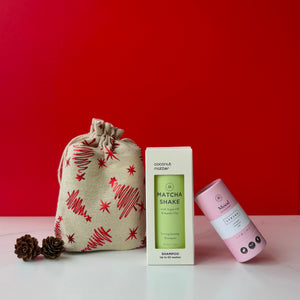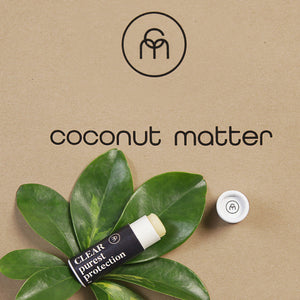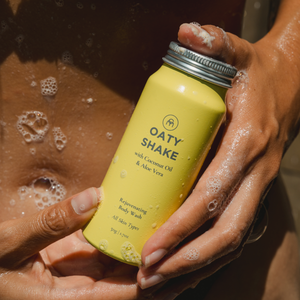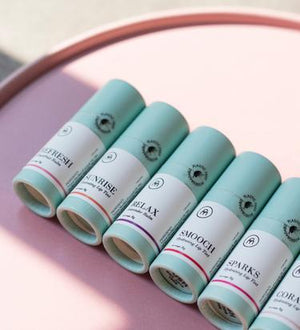
Prevent and Treat Underarm Rash from Deodorant: The Ultimate Guide
Nobody likes to have itchy rashes under their arms from using deodorant. These rashes can make your skin red, puffy, bumpy, and really itchy. Sometimes, trying a new product can cause a little bit of irritation. But if the rashes keep coming back, it might mean you're sensitive to something in the deodorant.
Often, deodorant rashes are caused by chemicals like aluminium, artificial fragrance, and alcohol which are in many regular antiperspirants deodorants. The rash could also be from shaving, blocked pores, or an allergic reaction to an ingredient in the deodorant.
It's annoying, but you can find ways to help your skin feel better. The first step is to figure out what's causing the rash. After that, you can use gentle, soothing things to help your skin. Keep reading to learn more about why deodorants can cause underarm rashes and how you can get rid of them for good.
What's Causing Your Underarm Rash? 7 Things That Might Surprise You
1. Aluminium
Lots of antiperspirants have a chemical called aluminium. Examples are aluminium chloride, aluminium chlorohydrate, and aluminium zirconium. These are used to make your pores smaller so you won't sweat as much. But, these aluminium salts can really bother some people's skin.
When aluminium mixes with sweat and cells in your pores, it creates a blockage. Your body sees this as something it doesn't want and tries to fight it off. This can cause your underarms to become red, bumpy, swollen, and very itchy. If you keep using an antiperspirant with aluminium, it can make things worse over time. Your skin might get scars, dark patches, or little lumps called granulomas. So, aluminium compounds in deodorants are a big reason why people get painful and uncomfortable underarm rashes, or darken pits.
2. Chemical Fragrances
Synthetic fragrance, like phthalates and parabens, are often added to deodorants and antiperspirants to make them smell good or to mask body odour. But these strong chemicals can cause a skin problem called contact dermatitis, especially in the sensitive underarm area and if you use them a lot.
These chemical fragrance can go deep into your pores, causing redness, stinging, swelling, bumps, peeling, flaky skin, and rashes. People who are sensitive to many chemicals react more easily. Your underarm skin soaks up what you put on it, and these scents contain lots of hidden compounds that can irreparably harm skin cells over time.
3. Alcohol-Based Formulas
Many deodorants and antiperspirants have alcohol in them. It helps the product to dry quickly and helps other ingredients work better. But alcohol can be very irritating and drying for the delicate skin under your arms. It takes away natural oils that protect your skin, making it easier for irritation to happen.
It's common to feel stinging and burning when you put it on, and your skin may become red, raw, and flaky. This irritation and rash can get worse if you shave, which opens up your pores and lets the alcohol soak in. People with dry skin are more prone to this problem.
4. Shaving Irritation
When you shave your underarms, you can get tiny cuts and scrapes. This can hurt a lot if you put on deodorant or antiperspirant after shaving because the chemicals can go into your open pores and cuts. This can make your skin red and cause painful bumps, especially if there's alcohol in your deodorant. Ingrown hairs can also make shaving rashes worse.
Chemicals like synthetic fragrance and aluminium salts can make the irritation worse when they penetrate your freshly shaved skin. This can make your underarms really prone to rashes from deodorant after you shave.
5. Blocked Sweat Glands/Heat Rash
When you use deodorant or antiperspirant a lot, things like dead skin cells, sweat, oil, and leftover product can build up in your underarm hair follicles and sweat ducts. This can block the pores, trap sweat under your skin, and cause small red bumps known as prickly heat rash or miliaria rubra. The area might tingle, burn, and feel really irritated.
Bacteria love to grow in this blocked, damp area. The problem can get worse if your skin rubs together and causes more sweat. People living in hot, humid places are most likely at risk for these side effects.
6. Allergic Reactions
Sometimes, the ingredients in deodorants and antiperspirants can cause allergies. This can happen even if you've used them before without any problems. Commonly known ingredients that may cause allergies are; synthetic fragrances, parabens, triclosan, metals like nickel, preservatives that release formaldehyde, and even natural ingredients like essential oils.
It's important to remember that just because a product says it's 'natural' or 'organic' doesn't mean it can't cause allergies. Our bodies can react to natural products the same way they react to chemical ones. For example, some people might get allergies from certain natural essential oils used in deodorants or from baking soda, which is often found in these products.
So, how do allergies happen? Our skin acts like a shield. It tries to keep out foreign substances which it thinks are bad for your body. This is different for everyone. When our skin encounters something it thinks is bad, our body tries to fight it off. This can cause allergies. This can lead to red, raised, itchy rashes and bumps, often just in the area where we put the deodorant.
If you get a rash or bumps after using an antiperspirant deodorant, it might be a good idea to stop using it until you figure out what caused the allergy. Remember, everyone's skin is different. What causes an allergy in one person might not in another. It's not that these things are bad for everyone; they just might not be good for your skin. Always try to find what works best for you.
7. Transition Period
When you stop using an aluminium based antiperspirant and start using a natural deodorant, your underarms go through a detox process. This usually lasts about 2-4 weeks while your body gets rid of the build up of old antiperspirant.
Things like old antiperspirant leftovers, dead skin cells, oil plugs, and bacteria come up to the surface of your skin. This can cause temporary irritation, stinging, red bumps, peeling, and rashes. After this adjustment period, your pores will get back to normal and get stronger. But this short-term irritation, known as the "natural deodorant detox," can be scary if you don't know what's causing it.
Bye Bye Underarm Rash: 5 Tips To Prevent Irritated Skin
1. Switch to an Aluminum-Free, Sensitive Skin Natural Deodorant
Do you get rashes under your arms from your antiperspirant? The best way to solve this problem is to switch to a natural deodorant that doesn't have aluminium and is made for sensitive skin. These natural deodorants don't have any harsh chemicals. Instead, they use ingredients like natural oils, minerals, and plants to stop bad body odour. They're ideal for sensitive skin, as they don't contain chemicals that can bother your skin like baking soda, synthetic fragrances, and alcohol.
These gentle ingredients can calm down skin that's red or swollen and help reduce rashes over time. A good example of a natural deodorant that's easy on your skin is one called MOOD Deodorant. It has soothing ingredients like coconut oil and shea butter that can hydrate and repair irritated skin. And since MOOD natural deodorant doesn't have any aluminium, it can prevent symptoms usually caused by blocked pores and stop bad smells from coming back.
2. Use Unscented Deodorant Options
Did you know that synthetic fragrance in your antiperspirant deodorant can cause underarm rashes and a skin problem called contact dermatitis? If you have this problem, you can stop the irritation by using an unscented deodorant. A good one to try is called COCONUT from the MOOD deodorant range. This deodorant is made with coconut oil and doesn't have any synthetic fragrance or essential oils. It's a great choice if your skin is sensitive.
Unscented deodorants can keep you from being exposed to hundreds of hidden chemicals that are often in synthetic fragrance. These can build up in your skin over time. So if you see that products with fragrance are causing you to have irritation or rashes, it might be time to try an unscented option.
3. Apply After Shaving to Avoid Irritation
Have you ever put on deodorant right after shaving your underarms? Doing this can cause a lot of stinging and rashes. This is because when you shave, you can get tiny cuts. If you put on deodorant right away, the chemicals in it can get into these cuts. This can really hurt and cause your skin to get red and bumpy.
To avoid this, it's a good idea to wait a bit before putting on deodorant after you shave. This gives your skin time to heal. When your skin is healed, it can handle the deodorant better and you're less likely to get a rash.
This is especially important if you notice that your underarms are getting darker. Sometimes, skin can get darker because of irritation. Waiting to apply deodorant after shaving can help keep your skin healthy and its normal colour.
4. Exfoliate Regularly to Prevent Clogged Pores
Taking good care of your underarms can help prevent problems like clogged pores and rashes. A key step in this care is gentle scrubbing. You might think about using a body scrub, but these can be too strong for your underarms. Instead, try using a mild facial scrub specifically for your underarms. These facial scrubs are made to be gentle on the skin, which makes them a perfect choice for your delicate underarms.
Pairing your scrub with a gentle skin cleanser can also help. Try to avoid using harsh products like salicylic acid. This can help keep your pores clear, which means less blockages and fewer ingrown hairs.
5. Gradually Transition Between Products
Sometimes you might want to change the deodorant you use. Maybe you found a new one you really like. Or maybe your old one is causing a rash or making your underarms darker. Whatever the reason, it's important to change deodorants slowly. This can help your skin adjust to the new product.
Try this: don't stop using your old deodorant right away. Instead, start by using your old deodorant and the new one on different days. Then, slowly start using the new one more and more. Doing this over 2-4 weeks can help prevent the irritation that some people get when they stop using one deodorant and start using another one all at once.
Remember, be patient with your skin. Listen to it. If it starts to feel irritated, it might be a sign that you're changing deodorants too fast.
For more tips on how to change deodorants smoothly, check out our blog post, "Get Ready to Detox: What Happens When You Switch to Natural Deodorant". It has lots of helpful information to make the switch as easy as possible.
Home Remedies for Armpit Rash
Deodorant can sometimes cause rashes, especially if your skin is sensitive. If this happens to you, try these cooling home remedy ideas to help your skin feel better.
If you have a painful rash under your arms, a cold compress can help make it feel better. Here's how to do it: wrap an ice pack in a towel and put it on the rash. Leave it there for 10-15 minutes. You can do this a few times a day. The cold can help reduce any swelling and make the area less tender.
Did you know you can also use cucumber to cool down your rash? Cucumber is really good at calming down your skin and making it feel better. Just take some chilled cucumber slices and put them on your rash. It's a great natural way to help your skin recover.
Remember, if your rash doesn't get better or if your skin starts to darken, don’t hesitate to see a doctor. They can help figure out what's causing the rash and how to treat it.
Listen to Your Skin: Identifying and Soothing Underarm Rashes
Understanding the causes of underarm rashes and darkened skin is the first step towards finding solutions. Deodorant can sometimes be the culprit, especially if it contains ingredients like aluminium or strong fragrances. Shaving can also contribute to skin irritation, as can clogged pores and quick transitions between different deodorant products.
However, with careful choices and mindful practices, it is entirely possible to keep your underarms fresh, healthy, and rash-free. Opt for a gentle, aluminium-free deodorant to avoid pore-clogging ingredients. Allow time between shaving and deodorant application to reduce the chance of irritation. Regular, gentle exfoliation can help keep your pores clear and prevent blockages.
When switching deodorants, remember to transition gently over several weeks rather than going "cold turkey". This helps prevent your skin from getting shocked and can reduce the likelihood of a rash.
Above all, listen to your skin. If it's reacting negatively to a product or practice, try something different. Don't hesitate to see the doctor if necessary. With some patience and care, you can keep your underarms feeling and looking their best. Remember, a rash-free underarm is a happy underarm!
Frequently Asked Questions
How can I tell if my deodorant is causing a rash?
You can identify a deodorant rash by looking for signs on your skin where you apply your deodorant. These signs, or deodorant irritation symptoms, can include:
- Your skin having a different colour or looking red or inflamed
- Feeling itchy or like it's burning 🔥
- Seeing little bumps or swelling
- Dry or peeling skin
It's important to differentiate between a deodorant rash and other skin conditions. To figure out how to tell if deodorant is causing a rash, think about these questions:
- Is the rash localized to the area of application?
- Did the rash show up after you started using a new deodorant?
- Did the rash start even though you've used the same kind of deodorant for a while?
At Coconut Matter, we know that sometimes a rash can appear even with a deodorant you've used for a long time. This can be due to too much being applied, or if the deodorant was applied immediately after shaving, or if it was used with another skin product such as whitening toner or glycolic acid.
To keep rashes away, just use a little bit of deodorant, don't put it on right after you shave, and don't mix it with other strong skin products. If you get a rash, stop using the deodorant and see if the rash gets better. If it still doesn't, you might want to chat with a skin doctor.
Is it safe to use deodorant on broken or irritated skin?
Understanding the right frequency for deodorant application is essential for maintaining fresh underarms and preventing discomfort. At Coconut Matter, we value the importance of tailor-fitting your deodorant routine to suit both your skin's unique needs and the specific formulation of the product you choose.
The effectiveness of deodorant not only hinges on individual skin chemistry but also on the product's formulation. Typically, once-a-day application is enough to keep you smelling fresh from dawn to dusk 🌅 to 🌃 and avoid rashes caused by overuse. Nevertheless, the optimum number of times to apply deodorant will vary from one individual to another, depending on lifestyle and personal preference. In addition to your morning routine, you may feel the need for a refresh after a midday workout 🏋️♂️ or before a social event 🎉.
When considering deodorant usage to prevent rashes, it's important to apply the product cautiously. Our MOOD natural deodorants, for instance, are highly concentrated, and a little goes a long way. Excessive use can lead to irritation, so if you require more than the standard once-a-day, ensure your underarms are clean and dry before reapplying.
Different deodorant types—such as roll-on, spray, or stick—have varying application frequencies. Roll-on and stick deodorants typically provide lasting coverage with just one application, while sprays may need a quick reapplication due to their lighter consistency. Regardless of the form, overuse can potentially lead to sensitivity, so moderation is key.
- Roll-on 🔄: Typically one application per day is sufficient.
- Spray 💨: May require a quick reapplication, especially if it's a lighter formula.
- Stick 🚫: Designed for lasting coverage with a single application.
If you experience any sensitivity, consider this as feedback from your skin, and adjust your usage accordingly. Finding the right balance in the quantity and frequency of deodorant application is the best way to keep you feeling confident and your skin irritation-free.
Remember, everyone's body chemistry is unique, so listen to yours and adjust your deodorant application accordingly. 👂🧴
How often should I apply deodorant to avoid getting a rash?
Understanding the right frequency for deodorant application is essential for maintaining fresh underarms and preventing discomfort. At Coconut Matter, we value the importance of tailor-fitting your deodorant routine to suit both your skin's unique needs and the specific formulation of the product you choose.
The effectiveness of deodorant not only hinges on individual skin chemistry but also on the product's formulation. Typically, once-a-day application is enough to keep you smelling fresh from dawn to dusk 🌅 to 🌃 and avoid rashes caused by overuse. Nevertheless, the optimum number of times to apply deodorant will vary from one individual to another, depending on lifestyle and personal preference. In addition to your morning routine, you may feel the need for a refresh after a midday workout 🏋️♂️ or before a social event 🎉.
When considering deodorant usage to prevent rashes, it's important to apply the product cautiously. Our MOOD natural deodorants, for instance, are highly concentrated, and a little goes a long way. Excessive use can lead to irritation, so if you require more than the standard once-a-day, ensure your underarms are clean and dry before reapplying.
Different deodorant types—such as roll-on, spray, or stick—have varying application frequencies. Roll-on and stick deodorants typically provide lasting coverage with just one application, while sprays may need a quick reapplication due to their lighter consistency. Regardless of the form, overuse can potentially lead to sensitivity, so moderation is key.
- Roll-on 🔄: Typically one application per day is sufficient.
- Spray 💨: May require a quick reapplication, especially if it's a lighter formula.
- Stick 🚫: Designed for lasting coverage with a single application.
If you experience any sensitivity, consider this as feedback from your skin, and adjust your usage accordingly. Finding the right balance in the quantity and frequency of deodorant application is the best way to keep you feeling confident and your skin irritation-free.
Remember, everyone's body chemistry is unique, so listen to yours and adjust your deodorant application accordingly. 👂🧴
How can I soothe underarm skin after a rash has occurred?
If you've developed a rash under your arms, you may be looking for effective methods for soothing underarm rash. Below are seven steps for post-rash skin care to help in treating skin after deodorant rash:
- Put the Deo on Hold: First things first, halt the roll-ons and sprays. When treating skin after deodorant rash, giving your underarms a breather from any deodorants or antiperspirants is a must.
- Gentle Cleansing: Clean your underarms with a mild, fragrance-free soap and cool water. Pat the area dry softly, avoiding any harsh rubbing that can worsen the rash.
- Soothing Application: For immediate relief, apply anti-inflammatory substances such as aloe vera gel or coconut oil. These natural remedies are excellent for soothing underarm rash and providing moisture.
- Soft Clothing: Dress in loose, soft clothing made from natural materials like cotton. This helps reduce friction and lets your skin breathe, which is crucial for post-rash skin care.
- Rash Relief: Apply an over-the-counter hydrocortisone cream if needed, following the package instructions, to alleviate itching and inflammation.
- Keep Cool: Avoid activities that induce sweating. Staying cool is essential to prevent further irritation of the rash.
- Professional Advice: If the rash persists or if you often experience rashes, it's important to consult with a healthcare professional for personalised care.
Following these seven steps can provide relief and promote healing for those experiencing discomfort from an underarm rash. Before you know it, you'll be waving your hands in the air like you just don't care – rash-free and happy as Larry! 🌈👍
Can children or teenagers use the same deodorant as adults without risking a rash?
When it comes to keeping our young ones smelling as fresh as a daisy, picking the right deodorant for children is key. To ensure you are selecting safe deodorants for young skin, consider these points:
- Gentle is the New Strong: Look for deodorants that are made with sensitive skin in mind. These gentle ingredients avoid harsh chemicals that could upset the skin's microbiome.
- Fragrance-Free: It's tempting to go for a deodorant that smells like a basket of fruit or a burst of flowers. But synthetic fragrances can cause allergies such as skin irritation or headaches. For kids under 7, you're best off sticking to unscented deodorants. As for the older child, natural deodorants infused with essential oils can be mood-lifting magic and safe for the pits! 🌸
- Aluminum and Alcohol-Free: Consider deodorants that are free from aluminium, alcohol, parabens, and propylene glycol, as these ingredients can cause skin irritation and are often unnecessary for the less intense body odour associated with children and teenagers.
- Patch Testing: Always perform a patch test with any new deodorant on a child's less sensitive skin (such as arms or legs) and wait 24-48 hours to check for any adverse reactions.
- Avoid Known Allergens: Be mindful of ingredients that are commonly known allergens, such as baking soda, which can cause irritation for some individuals. Other ingredients to avoid include synthetic fragrances, preservatives like formaldehyde, and certain essential oils that are known irritants.
- Natural Ingredients: Opt for deodorants that contain gentle, natural ingredients such as coconut oil, which is known for its skin-soothing and moisturising properties.
- Avoid Overapplication: Instruct children and teenagers to apply deodorant lightly. Applying too much deodorant can lead to buildup and irritation.
- Hygiene High Five: Good ol' soap and water does wonders. Especially for younger children, it is crucial to teach them proper underarm cleaning to prevent any product residue buildup and to maintain good hygiene practices.
- Doctor's Orders: When in doubt, consult with a healthcare professional.
By carefully selecting deodorants appropriate for the age and skin sensitivity of children and teenagers, and by emphasising the importance of proper application and hygiene, you can help protect young skin from irritation and rashes. 🌼👍
How does shaving impact deodorant-related underarm rash?
Navigating the delicate balance between shaving and deodorant application can be a bit tricky, but fear not! For those on a mission for serene underarm skin, understanding the nuances of shaving before deodorant application is a game-changer.
The Lowdown on Shaving and Deodorant Rash
- Skin Abrasion: Shaving can remove the top layer of skin, leading to abrasions that may react negatively when deodorant is applied, causing irritation or a rash. 🤕
- Skin Sensitivity: The underarm area is more sensitive post-shaving. To avoid that stinging sensation or worse, a rash, it's best to give your skin some time to recover before reaching for your deodorant. 🧴
- Perfect Timing: Wondering about the best time to apply deodorant? To avoid discomfort, let your pits have a peaceful night's rest post-shave, then apply your deo in the morning. 🌙➡️🌞
- Alcohol-Free Deodorants: If you've been battling underarm shaving irritation, try embracing a deodorant that's alcohol-free. It's like choosing a gentle cuppa over a strong espresso for your pits – much less of a shock to the system! ☕
- Sharp Moves: A sharp razor and a kind shaving cream are your best mates for minimising underarm shaving irritation. Avoid using dull blades that can pull hairs and irritate the skin, which may make it more susceptible to rashes after deodorant is applied. 🪒
- Hydration Station: After shaving, it's beneficial to hydrate the skin with a soothing agent like coconut oil, which is known for its moisturising and calming properties. After the skin has been soothed and is completely dry, applying deodorant should be safe. 💧
- Pick Wisely: To keep shaving and deodorant rash at bay, reach for products without those pesky irritants like baking soda, synthetic fragrances, or parabens. 👍
By tweaking your routine and considering the timing of shaving before deodorant application, you can keep your underarms jolly and rash-free. And there you have it – follow these tips to prevent the occurrence of deodorant-related rashes and maintain comfortable, healthy underarm skin.
Is it better to use deodorant in the morning or at night to prevent rashes?
Delving into the quest for odour-free underarms, one might ask, "What's the best time to apply deodorant?" It's a brilliant question, and we're here to clear the air. While you might've heard that antiperspirants are best slapped on at night for their sweat-blocking prowess, deodorants work differently.
Why is Morning the Champion Time for Deodorant?
- Active Ingredient Action: Deodorants are like your personal odour bodyguards, and they're all about keeping you smelling fresh. Timing deodorant application to the morning means those active ingredients are working exactly at the time when you're getting your hustle on, keeping those stinky odour-causing bacteria in check.
- Skin Recovery Rituals: Giving your skin a breather at night is a top-notch idea. It's a bit of respite that helps keep your skin balanced and could be just the way to avoiding rashes.
- Sharp Shaving Strategy: Let's face it, shaving can be a bit of a faff, and doing it in a hurry can leave your pits feeling prickly. By shaving at night, you're giving your skin a chance to settle down before the morning deodorant routine.
- Daily Hygiene Harmony: Gliding on natural deodorant after your morning cleanse is spot on. Clean, dry skin is the perfect canvas for your deo, making it a savvy move to ward off rashes.
Morning vs Night Deodorant Application: The Verdict
Aligning your deodorant application with your morning ritual is a solid strategy for staying fresh. It's all about getting your timing right to avoid rash and making sure your underarms are in tip-top shape for the day ahead. So, embrace the morning deo routine and step out the door with confidence, knowing you're sorted in the freshness department! 🌞👌
How does sweating affect deodorant-induced underarm rashes?
4 Super Simple Tips to Avoid Sweating and Deodorant Rash
Keep It Dry: When you're sweating a lot, your skin can get irritated easily. Try to keep your underarms dry to cut down on rash risk. 💨
Bacteria Be Gone: Sweaty skin can create bacteria that makes smell more likely. Use a good deodorant to help keep those little odour-causing bacteria away. 🦠🚫
Gentle Ingredients: Some deodorants have harsh ingredients in them that can upset your skin’s balance and make you sweat more. Pick a deodorant like MOOD deodorant with kinder ingredients. 🌱
Don't Block Your Pores: Using too much deodorant, especially when it's hot and you're sweating, can clog up your pores and lead to rashes. 🚫🧴
Now, let's make it even easier to remember:
Choose Wisely: Pick a deodorant that's nice to sensitive skin to avoid irritation. 👌
Apply Just Enough: Only use a small amount of deodorant to keep pores happy. ✅
Wear Comfy Clothes: Dress in clothes that help keep you cool and dry. 👕💨
Clean Is Key: Wash and dry your underarms well before putting on deodorant to help stop bacteria. 🧼
Stick to these simple steps and you'll help keep your underarms rash-free, even with the irritation of sweat on your skin.
Can certain fabrics worsen underarm rashes from deodorants?
Do your underarms feel irritated after using deodorant? It might not just be what you're applying to your skin, but also what you're wearing. We're delving into the connection between clothing fabric and deodorant rash to help you keep your underarms content.
The truth is, the type of fabric you wear can indeed aggravate underarm rashes, particularly if your skin is sensitive. Some materials can cause friction and irritation, much like a scratchy label on a jumper.
For those with delicate underarms, selecting the best clothes is key. When we talk about fabric types and skin irritation, natural fibers are your allies. Fabrics like cotton, bamboo, and silk are superb because they're soft on the skin and allow it to breathe, reducing the risk of sweat or deodorant causing any upset.
Conversely, synthetic fibers such as polyester and rayon might not be the wisest choice. They tend to keep moisture close to the skin and can create unwanted friction, leading to discomfort.
When choosing your outfit, consider the best clothes for sensitive underarms. Opt for garments made from gentle, breathable materials, and you'll be doing your underarms a huge favour.
By selecting the appropriate attire, you can effectively reduce the chances of developing deodorant rash. Stay cool, stay natural, and maintain happy underarms. 🌿👕
How can I transition to a new deodorant to minimise the risk of a rash?
Are you considering a switch to a new deodorant but worried about the risk of developing a rash? Transitioning to a new deodorant can be a gentle process with the right approach. Here's how you can change your deodorant with confidence:
Ease into Switching Deodorants Safely.
When you're ready to make the move to a new deodorant, it's best to do so gradually. Begin by applying the new product sparingly to see how your skin reacts. This can be especially important if you're moving to a natural deodorant, as your body may need time to adjust.
Cleanse Gently
Keep your underarms clean by washing them daily with a mild soap. This helps to remove any build-up of bacteria and dead skin cells, which can contribute to irritation.
Test Your Skin's Reaction
Before going all in, test the new deodorant on a small patch of skin on your arms or legs. If there's no adverse reaction after a day or two, you should be okay to use it more broadly.
Stay Hydrated and Moisturised
Applying a light, unscented moisturiser to your underarms can help to create a protective barrier for your skin, potentially reducing the risk of irritation as you transition to a new product.
Wear the Right Fabrics
During the transition period, wearing loose-fitting clothes made from natural fabrics, such as cotton, can help to prevent chafing and irritation.
Be Patient and Observant
Patience is vital when transitioning to new deodorant. Keep an eye on your skin for any signs of a rash and if you do notice irritation, give your skin a break before trying again.
By following these simple steps, you can make the shift to a new deodorant smoothly and with minimal risk of developing a rash. Remember, it's all about taking it slow and listening to your body.
Is it safe to use deodorant during pregnancy or breastfeeding?
At Coconut Matter, we understand the importance of being extra cautious with personal care products during pivotal times like pregnancy and breastfeeding. When it comes to using deodorant during these sensitive periods, we have a few recommendations to ensure safety and peace of mind.
First Trimester Care
During the first trimester, it's advisable to avoid products infused with essential oils. The body is undergoing significant changes, and heightened sensitivity can occur. By choosing products without essential oils, you reduce the risk of unwanted skin reactions or sensitivities.
Breastfeeding and Scent
Newborns rely heavily on their sense of smell for bonding and feeding, especially when learning to latch. To facilitate this natural process, we recommend using unscented deodorants. This helps to maintain the mother's natural scent, which is crucial for a newborn's ability to recognise and bond with their mother.
All-Natural Mood Deodorant
Our all-natural MOOD deodorant is crafted with these considerations in mind. Made safe for everyone, including expectant and new mothers, our deodorant is free from potentially harmful chemicals. By using MOOD deodorant, you're choosing a product that's gentle, effective, and mindful of both maternal and infant needs.
For those navigating the beautiful journey of pregnancy and early motherhood, you can trust Coconut Matter's MOOD deodorant to be a safe and supportive choice for your daily routine.
Can stress or hormones affect deodorant-induced underarm rashes?
Navigating the world of personal care during times of stress or hormonal changes can be tricky, especially when it comes to understanding the link between emotional health and skin reactions like underarm rashes. Let's delve into the connection between stress and deodorant rash, as well as the hormonal impact on skin irritation.
The Role of Stress in Skin Health
Stress can indeed play a significant role in the health of your skin. When stressed, your body produces more cortisol, a hormone that can increase oil production in your skin glands, potentially leading to irritation and rashes. So, if you're experiencing higher levels of stress and notice a rash under your arms, your emotional state could be a contributing factor.
Hormonal Fluctuations and Skin Sensitivity
Similarly, hormones can affect your skin's sensitivity, and changes in hormone levels might make your skin more prone to irritation from deodorants. For instance, during certain times in your menstrual cycle or life stages like pregnancy or menopause, you might notice your skin reacting differently to products you've used before without issue.
Combating Underarm Rash and Emotional Health
To tackle an underarm rash, consider the following steps:
- Choose the Right Deodorant: Opt for a gentle, non-irritating deodorant, especially during periods of hormonal fluctuation or high stress.
- Maintain a Balanced Lifestyle: Keeping stress at bay with a balanced diet, regular exercise, and adequate sleep can help maintain healthier skin and reduce the likelihood of rashes.
- Monitor Skin Reactions: Pay attention to how your skin reacts to your deodorant during different times. This can help you identify patterns and choose products that minimise irritation.
In conclusion, both stress and hormones can influence the occurrence of deodorant-induced underarm rashes. By understanding the impact of emotional health and hormonal changes on your skin, you can take proactive steps to minimise discomfort and maintain healthy, happy underarms.
How do environmental factors like heat or humidity affect underarm rashes?
In regions of the World like Hong Kong, where the mercury soars and humidity clings heavily in the air, the battle against underarm rashes is all too familiar. The climate impact on deodorant rash is a significant concern for many, as both heat and humidity can intensify underarm irritation and sensitivity to deodorants.
Heat can increase sweat production, leading to a moist environment that's uncomfortable and potentially irritating. In turn, humidity compounds this by preventing sweat from evaporating, trapping it against the skin. Such conditions can cause deodorants and antiperspirants to work overtime, sometimes reducing their effectiveness and potentially leading to rashes.
Here are a few tips to help you manage underarm health:
- Stay Dry: Keep your underarms as dry as possible. Applying talc-free powder can help absorb excess moisture.
- Choose Wisely: Look for deodorants specifically designed for sensitive skin, which are less likely to cause irritation in extreme weather.
- Wear Breathable Fabrics: Natural fibres such as cotton allow your skin to breathe, reducing sweat and irritation.
In hot and humid climates, standard deodorants often fall short. That's why we spent over two years perfecting MOOD deodorant, ensuring it reliably protects and reduces rashes, keeping underarms comfortable in any weather.










